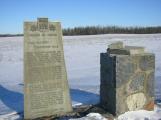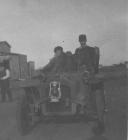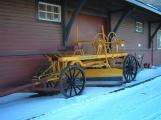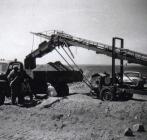1
Coming to Saskatchewan just as it was becoming a province was a major undertaking. Pioneers had to rely on the trails made by the First nations people and the Métis traders, the main one being the Carlton Trail. Carts, wagons and sleds pulled by horses were the only way to move things and if you didn't have those, you walked.For many years the Trail was the lifeline to the West until settlement and railroads arrived and it was no longer needed. To this day only small portions of the Trail remain to be seen. One part can be pinpointed south of Jansen at the NW corner of the PFRA pasture and also inside the pasture where the land has never been broken. A marker just east of Lanigan on Highway 16 shows where the Carlton Trail went from the SE to the NW.
2
Carlton Trail MonumentCirca. 1995
R.M. of Usborne, Saskatchewan
 Credits:
Credits:Lanigan and District Heritage Assoc,
4
Irene Hodges writes: "Our Lanigan 1905-55 History Book tells us of an incident where Mr. And Mrs. King arrived in Humboldt in 1905 and decided to walk to their new homestead just southeast of Lanigan. They felt the $25 charged by the liveryman was too much. After walking 35 miles they reached the swollen waters of Wolverine Creek and found they could not cross so sadly turned back. Luckily they met a man with a team and wagon and they were taken to their new home.
Walking to Humboldt to get mail and supplies was not uncommon in the early years. Our History book records, "In the first year or two Scotty (Davidson and some of his neighbors would walk to Humboldt --- over the Old Carlton Trail."
6
When the DavidsonBrothers, Russell Hill and Bob Hackward came to find their homesteads their diary tells us that they walked from Arlington Beach to this area and back again. A steamboat on Last Mountain called the The Lady of the Lake (later christened Qu'appelle) that had brought the new homesteaders north, took them back again to Craven where they caught a stagecoach to Lumsden and then a train to Regina to register their land application.
The coming of the railroads soon put the Pearson steamboat transportation out of business. Even though the company turned to providing pleasure tours the old rundown boat no longer was safe and met its demise on November 11, 1918 when a celebrating crowd used it to make a victory bonfire."
7
Lady of the LakeCirca. 1904
Last Mountain Lake, Saskatchewan
 Credits:
Credits:A History of Long Lake District
Lanigan and District Heritage Assoc.
8
Trails were abandoned when country roads were finally built as designated by the survey. At first these weren't much more than a trail but gradually were built up to accommodate trucks and cars. The first car in Lanigan was a Reo chain driven model driven from Elgin, Manitoba by Bob Folley and his wife in 1908. What an experience that would have been! If only there was a diary of that trip.
9
Kerosene Lantern HeadlightsCirca. 1908
Lanigan, Saskatchewan
 Credits:
Credits:Lanigan and District Heritage Assoc.
10
The phenomenal growth of Lanigan town created major problems with the grading and gravelling of streets. They didn't have access to gravel, but daily the CPR were moving cars of gravel from their pit near Plunkett to their track east of Jansen. The Town approached an official of the railway asking if they might buy gravel to top one block of Main Street. The official replied, "The CPR do not sell gravel," but, he added, "Loaded gravel cars sometimes go out of order and we have to sidetrack them, if you see a car of gravel on the house track at the end of your main street you will oblige us by unloading it as quickly as you can." The following afternoon, three cars of gravel were on the house track. Eleven teams and wagons, men with shovels and lanterns went to work and by 4:am, the gravel was on the streets of Lanigan.As Lanigan developed with people, automobiles and industry, the need for roads was evident. These were laid out in the process of surveying. We find roads every mile running north and south and every 2 miles east and west. Some were only trails while others were graded with ditches on both side and low spots provided with wooden bridges or filled in with dirt to a higher elevation. The first roads were crude, made with horse drawn graders dragging dirt from the sides of the road allowance into the middle. Gravel roads were not yet to be, so when it rained, it made travel quite an adventure. Trees along the road allowance made it impossible to get through the snowdrifts in the winter. A trail across the field was common, reminding us of the Old Carlton Trail.
11
Highway 20 in Progress3 September 1930
Lanigan, Saskatchewan
 Credits:
Credits:Evelyn Gunther
Lanigan and District Heritage Assoc.
13
Road Grader - Early Days1920-1930
R.M. of Prairie Rose, Saskatchewan
 Credits:
Credits:R.M. of Prarie Rose #309
Lanigan and District Heritage Assoc.
14
Terex resting for the winterCirca. 2006
Lanigan, Saskatchewan
 Credits:
Credits:Lanigan and District Heritage Assoc.

